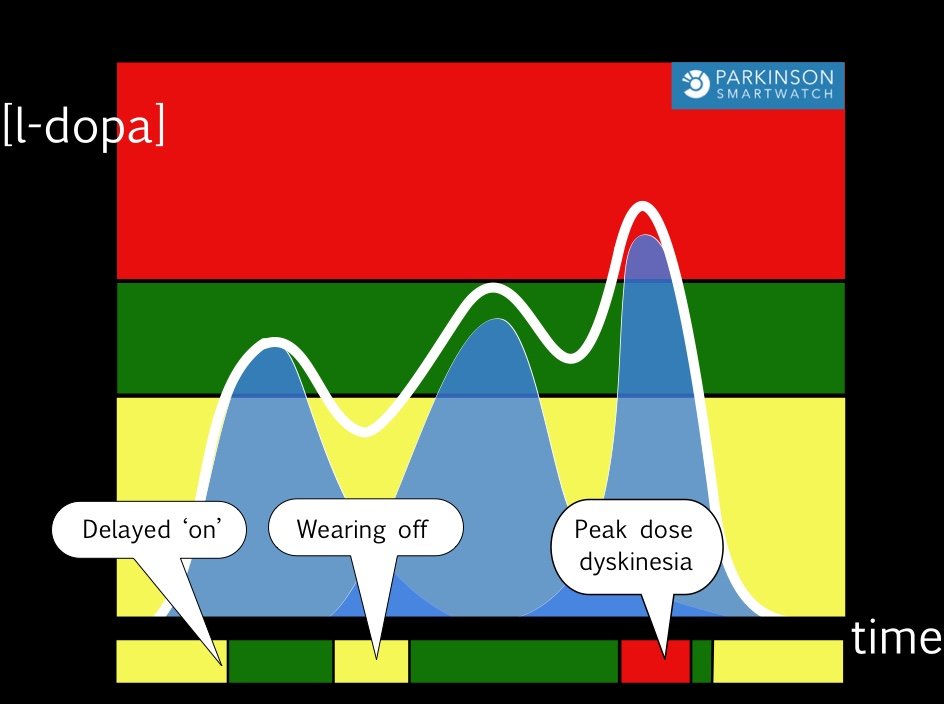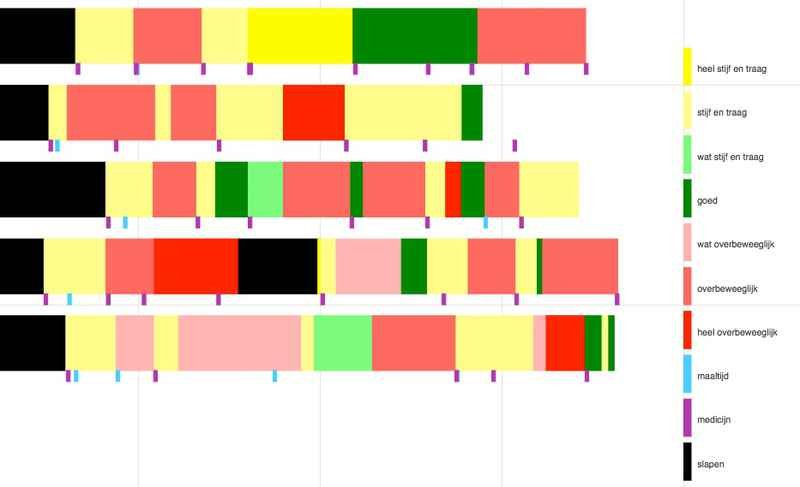Improve: recognise common patterns
The smart charts illustrate all the information that you have included in your Parkinson Smartwatch electronic diary. Getting familiar with some common patterns can help you to spot them in the smart charts, and allow you to discuss your treatment plan with your doctor and healthcare professionals more easily. The accuracy of the data recorded with the Parkinson Smartwatch helps to do so.

A delayed-‘on’ is easy to recognize: you experience a few ‘bad’ or ‘off’ hours each day before you start to feel better and reach a ‘good’ or ‘on’ state. This is a common problem, which is easy to solve, but which many people still suffer from daily. It is caused by the first dose of levodopa being too low.
Levodopa, is the best, the most powerful, and the cheapest medicine for Parkinson’s disease, but it only works at a certain level in each individual. The Parkinson Smartwatch system uses the color yellow to indicate ‘off’ or ‘bad’ periods and green to indicate ‘on’ or good periods.
Here is an example of a ‘delayed on’ day which has been recorded using the Parkinson Smartwatch:

The smart chart shows that the ‘good’ or ‘on’ state occurred at 11am, and that the period between waking at 7am and 11am was recorded as an ‘off’ or ‘bad’ period. ‘Delayed on’ could be seen on the smart charts as yellow periods at the start of each day.

If you or your doctor spot this pattern in the smart charts then you can discuss making changes to your treatment schedule. Please always discuss any changes to your medication with your doctor.

This smart chart illustrates the data for a person who has two ‘on’ or ‘good’ periods each day, whilst the rest of the day is considered ‘off’ or ‘bad’. The previous section ‘delayed on’ discussed the problems experienced between waking and the first ‘good’/’on’ period. The yellow periods which follow a green section indicate a ‘wearing off’ pattern (i.e. the second and third yellow periods on the smart chart seen above).
This means that the previous dose of medication was not high enough to get sustained levels [of levodopa]. This problem can be solved in several ways. Usually it means increasing levodopa doses. Please always discuss any changes to your medication with your doctor.
If the level of levodopa gets too high, or when the level peaks, it may cause involuntary movements, called dyskinesia.
The following smart chart illustrates the data for a person who has two ‘good’ or ‘on’ periods, indicated by green, intersected with a red period.

The Parkinson Smartwatch system uses the color red to indicate periods of ‘dyskinesia’ or ‘involuntary movements’. If this occurs, then then making adjustments to your treatment plan might not be straight forward. Whilst reducing a dose of levodopa may be useful, the aim is not to reduce it so much that it becomes an ‘off’ or ‘bad’ period. It usually requires very small changes to prevent this from happening, but sometimes it requires a new strategy.
Please always discuss any changes to your medication with your doctor.

The above smart chart illustrates the data for a person who experiences ‘on’ and ‘off’ and ‘dyskinesia’ periods all interspersed. Most of the people who experience this pattern take medicines at irregular times. Regulating the intake of medication is often the solution, so asking your doctor for a medication schedule for your treatment plan, and setting up medication reminders on your Parkinson Smartwatch, could be the key to getting back on track. Take the time to adapt your plan to achieve the best results. Please always discuss any changes to your medication with your doctor.
